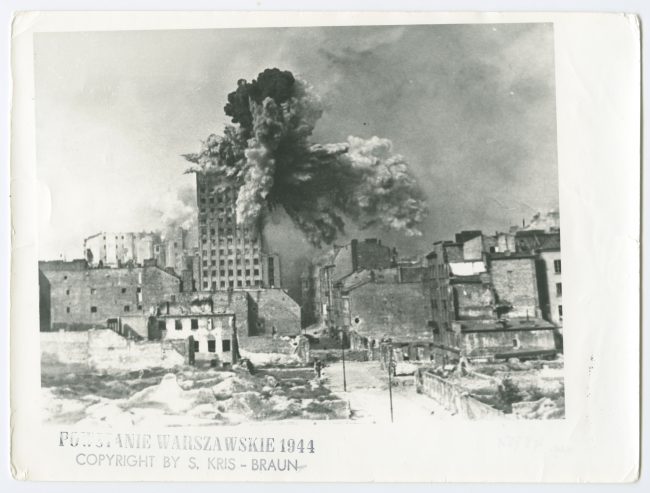
Exploding missile which hits the Prudential building during the Warsaw Uprising
The moment of explosion of a missile that on 28 August 1944 hit the most modern skyscraper in Warsaw at the time, the seat of the Prudential insurance company, was captured by Sylwester Braun (1909–1996), known under the Uprising code-name Kris, in six consecutive shots. The presented black and white print inaugurates the sequence and shows the moment of explosion. It was created by the photographer from the original negative in 1981 in the United States, where Braun settled down after the war. It bears a characteristic stamp which reads Warsaw Uprising 1944 / Copyright by S. Kris – Braun.
The Warsaw Uprising was an armed insurrection against the German army occupying Warsaw, organised by the conspiratorial armed forces. Sylwester Braun single-handedly created several sets of prints. In 1981, he donated one set alongside a set of original negatives to the Museum. Braun used the remaining sets in presentations, lectures and exhibitions which he organised for the Polish diaspora in America, primarily in California.
The sixteen-storey building, the highest in Warsaw at the time, was designed by Marcin Weinfeld (1884–1965), and erected in 1933. The modern steel and reinforced concrete structure was designed by Stefan Bryła (1886–1943) and Wenczesław Poniż (Slovenian: Venčeslav Poniž, 1900–1967). In 1936, Professor Janusz Groszkowski (1898–1984) launched the first transmitter of an experimental television station in Europe on the purpose-built mast on the roof of Prudential. The lower part of the skyscraper housed office spaces, whereas luxury apartments were located on the higher stories.
During the Warsaw Uprising, after the edifice was seized by insurgents in August 1944, the white and red flag was hung on the mast, and Prudential became a target of ongoing fire of the German artillery. Around thousand missiles were dropped in the vicinity of the building. The one visible in the photograph, which weighed nearly two tons and was fired from the heaviest self-propelled mortar, one of the seven such mortars used by the Germans during World War II (1939–1945), damaged the building, yet it did not destroy it. The modern welded structure endured the explosion.
The series of shots that document the consecutive phases of the explosion became an icon in the oeuvre of the photographer, who recalled: “Assuming that the Prudential edifice would become the target of German fire, a building whose upper storeys housed an insurgent observation point, I decided to check if my predictions were right. I ensconced myself on the roof of the house at 28 Kopernika Street. The weather was beautiful, clear morning sunshine, the panorama of wounded Warsaw close at hand.
The ruins did not obstruct the view. Smoke from fires was visible in the distance. Time passed. I controlled my Leica once again – f/8, 1/200 sec, distance: infinity. (…) I had spent an hour waiting when I noticed the yellow trail of a missile against the backdrop of azure sky. In the viewfinder, I saw Prudential being hit and the explosion in bloom – over a period of three seconds I took six photographs.” As a field war reporter of the Home Army Operational Command’s Office of Information and Propaganda, Braun produced approximately 3,000 negatives during the Warsaw Uprising.
Exploding missile which hits the Prudential building during the Warsaw Uprising
SYLWESTER BRAUN, CODE-NAME “KRIS”
WARSAW; 28 OF AUGUST 1944; PRINT 1981
PHOTOGRAPHIC PRINT
AN 49751/A
17,7 × 23,7 CM
Image licensed under: ![]()
